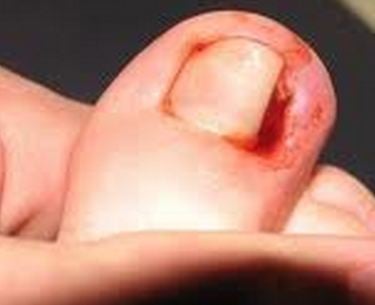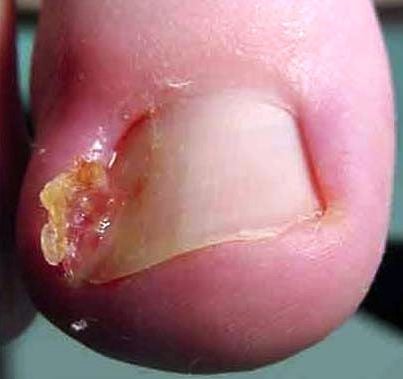Ingrown toenail pus oozing from your toes can be unhygienic and painful. Here’s how to remove and treat pockets of toenail pus, including yellow, green and white pus on toe nails that grow back into the flesh.
Pus oozing from an ingrown toenail is not unsightly but can also get stinky. It is also not often some good news since it is typically a sign of infection. So what should you do if an ingrown toenail suddenly starts discharging pus? Should you prick the toenail to get rid of the pus?
Ingrown Toenail Pus Removal
In addition to pulsating and intensifying pain, a warm feel, and increasing inflammation, redness and tenderness – as we
ll fever and chills in some more severe cases – pus is one of the common symptoms of infected ingrown toenail. The body only produces pus while fighting against an infection.
If you are like most people, you are used to piercing areas of the skin filled with pus to drain it out. The WebMD website however warns against this habit saying it often worsens the infection. On the same note you shouldn’t use some sharp object to dig out the ingrown toenail as that can as well cause more infection.
Talking of ingrown toenail pus removal options, you shouldn’t even try to do it. Period. All ingrown toenails with pus – signaling infection – should be treated by a doctor or a medical professional.
This is especially critical for people with diabetes and those suffering from vascular disorders or numbness in the toes. As the WebMD puts it, such patients are at higher risk of developing serious complications and may even end up losing their limbs if immediate treatment is not sought.
Your doctor may prescribe an antibiotic. The doctor may as well refer you to a podiatrist, a medical practitioner who deals with diagnosis and treatment of foot related diseases and conditions.
Surgery to remove a partial portion of the toenail or the whole of it may be necessary in some more severe and chronic cases of ingrown toenail.
As your ingrown toenail heals, you may want to consider wearing shoes that place little pressure on the toes such as open shoes and sandals.
Ingrown Toenail Pus Pocket
If you are wondering what to do to that ingrown toenail pus pocket that has formed on the skin fold next to your toenail, you should avoid the temptation to prick it with a sharp object e.g. needle as most people would.
Instead you should go see your doctor since it often an indication that you are dealing with a bacterial infection. Such pockets often respond well to treatment with a round of antibiotics but severe cases may necessitate ingrown toenail surgery to remove a part or the whole of the problematic toenail.
Your doctor may also include some analgesics to relieve some pain.
Ingrown Toenail Infection Pus – Surgery to Your Rescue
Chronic and severe cases of ingrown toenails often require surgical intervention to remove the problematic nail or part of it. This is especially commonly done for people whose natural nail shape is to blame for their condition (e.g. those with curved toenails) and those whose toenail is thickening while burrowing into the skin.
Toenail surgery is often classified into partial nail avulsion and full nail avulsion. Both are performed at a doctor’s office or surgery center under local anesthesia but differ in that partial nail avulsion involves the removal of only a small section of the nail whereas full nail avulsion involves the removal of the entire nail. For partial avulsion, a chemical known as phenol is usually injected into the base of the nail to prevent a regrowth of the removed part.
Coming back to our discussion (ingrown toenail infection pus removal), if an infected ingrown toenail requires surgery, any pus present is usually drained during the surgical procedure which is then followed with a prescription of oral antibiotics.
Ingrown Toenail Green Pus
An ingrown toenail that begins as a warm, red, and painful swelling of the patch of skin hanging on the side of the toenail, only to later form green pus that separates the skin fold surrounding the nail and the toenail itself – and often oozing out – is often an indication of an infection.
Staphylococcus aureus bacteria are to blame for most cases of ingrown toenail infections. It is found in abundance on human skin and is often harmless until a puncture in the skin (e.g. ingrown toenail) creates an entry point for them.
Although not very common, other species of bacteria such as Streptococcus species and Pseudomonas can also cause infection.
In addition to treatment with antibiotics, your doctor might suggest warm soaks 2 to 3 times per day to promote drainage and relieve you of some pain.
Ingrown Toenail Yellow Pus
And what does a yellow pus discharge mean? Well, it as well means that your ingrown toenail is infected. Yellow colored pus is a sign of stage 2 of ingrown toenail according to the DermnetNZ website.
In some instances, the pus produced may look greenish-yellow. As with green pus, yellow pus (or even greenish yellow pus) requires the attention of your doctor for proper diagnosis and treatment.
It is likely that the doctor will prescribe a dose of antibiotics (or cream) alongside other treatment option recommended, which could include surgery, or simple warm water soaks.
How to Treat Ingrown Toenail with Pus
Asked how to treat toenail with pus, my immediate response would be to stop treating the condition yourself. It is advisable to have your doctor look at the toenail for proper diagnosis and treatment. During treatment, the doctor may have to incise and drain the pus.

Your doctor may then prescribe an antibiotic cream such as Neosporin or, depending on his/her evaluation of medical history, prescribe oral antibiotics such as Di/flucloxacillin, Clindamycin, Cephalexin, and Acyclovir.
Di/flucloxacillin is the first choice among most podiatrists for treatment of ingrown toenails, but Cephalexin is often preferred for patients with a medical history of sensitivity to penicillin. It is therefore important to let your doctor know if you are sensitive to penicillin.
Your doctor may also deem it necessary to have surgery to remove part or whole of the toenail as explained in a previous section of this article.
Ingrown Toenail White Pus
The pus produced as a result of infection to ingrown toenail can as well be white. This is also a characteristic of stage 2 ingrown toenails according to the DermnetNZ website. Get your doctor to evaluate and accordingly treat your case.
Most such cases are treatable with antibiotics but surgery may be needed for particular cases such as thickening toenails.
 eTopical Precious Finds
eTopical Precious Finds




